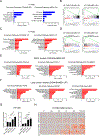Separable Cell Cycle Arrest and Immune Response Elicited through Pharmacological CDK4/6 and MEK Inhibition in RASmut Disease Models
- PMID: 39148328
- PMCID: PMC11614708
- DOI: 10.1158/1535-7163.MCT-24-0369
Separable Cell Cycle Arrest and Immune Response Elicited through Pharmacological CDK4/6 and MEK Inhibition in RASmut Disease Models
Abstract
The combination of CDK4/6 and MEK inhibition as a therapeutic strategy has shown promise in various cancer models, particularly in those harboring RAS mutations. An initial high-throughput drug screen identified high synergy between the CDK4/6 inhibitor palbociclib and the MEK inhibitor trametinib when used in combination in soft tissue sarcomas. In RAS mutant models, combination treatment with palbociclib and trametinib induced significant G1 cell cycle arrest, resulting in a marked reduction in cell proliferation and growth. CRISPR-mediated RB1 depletion resulted in a decreased response to CDK4/6 and MEK inhibition, which was validated in both cell culture and xenograft models. Beyond its cell cycle inhibitory effects, pathway enrichment analysis revealed the robust activation of interferon pathways upon CDK4/6 and MEK inhibition. This induction of gene expression was associated with the upregulation of retroviral elements. The TANK-binding kinase 1 inhibitor GSK8612 selectively blocked the induction of interferon-related genes induced by palbociclib and trametinib treatment and highlighted the separable epigenetic responses elicited by combined CDK4/6 and MEK inhibition. Together, these findings provide key mechanistic insights into the therapeutic potential of CDK4/6 and MEK inhibition in soft tissue sarcomas.
©2024 American Association for Cancer Research.
Conflict of interest statement
Competing Interests:
Both ESK and AKW have sponsored research funded by Blueprint Medicines and Bristol Myers Squibb. ESK is also affiliated with Cancer Cell Cycle-LLC.
Figures






Similar articles
-
Efficacy of the combination of MEK and CDK4/6 inhibitors in vitro and in vivo in KRAS mutant colorectal cancer models.Oncotarget. 2016 Jun 28;7(26):39595-39608. doi: 10.18632/oncotarget.9153. Oncotarget. 2016. PMID: 27167191 Free PMC article.
-
Stabilization of RUNX1 Induced by O-GlcNAcylation Promotes PDGF-BB-Mediated Resistance to CDK4/6 Inhibitors in Breast Cancer.Cancer Res. 2025 May 2;85(9):1708-1724. doi: 10.1158/0008-5472.CAN-24-2492. Cancer Res. 2025. PMID: 39937190
-
Coadministration of Trametinib and Palbociclib Radiosensitizes KRAS-Mutant Non-Small Cell Lung Cancers In Vitro and In Vivo.Clin Cancer Res. 2016 Jan 1;22(1):122-33. doi: 10.1158/1078-0432.CCR-15-0589. Clin Cancer Res. 2016. PMID: 26728409
-
Cost-effectiveness of CDK4/6 inhibitors in HR+/HER2- metastatic breast cancer: a systematic review and meta-analysis.Curr Med Res Opin. 2024 Oct;40(10):1753-1767. doi: 10.1080/03007995.2024.2402074. Epub 2024 Sep 21. Curr Med Res Opin. 2024. PMID: 39305463
-
Influence of ethnicity on cyclin-dependent kinase inhibitor efficacy and toxicity: A systematic review and meta-analysis.Breast. 2025 Feb;79:103833. doi: 10.1016/j.breast.2024.103833. Epub 2024 Nov 4. Breast. 2025. PMID: 39579620 Free PMC article.
References
-
- Mughal MJ, Bhadresha K, Kwok HF. CDK inhibitors from past to present: A new wave of cancer therapy. Semin Cancer Biol 2023; 88: 106–122. - PubMed
-
- Panagiotou E, Gomatou G, Trontzas IP, Syrigos N, Kotteas E. Cyclin-dependent kinase (CDK) inhibitors in solid tumors: a review of clinical trials. Clin Transl Oncol 2022; 24: 161–192. - PubMed
MeSH terms
Substances
Grants and funding
LinkOut - more resources
Full Text Sources
Miscellaneous

